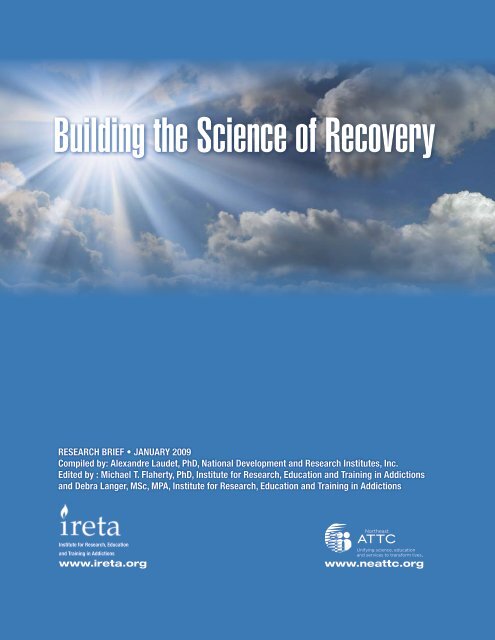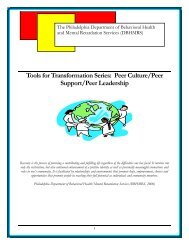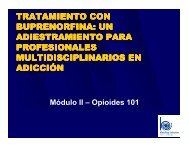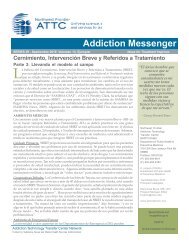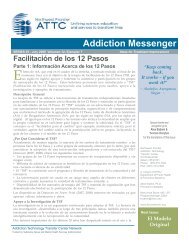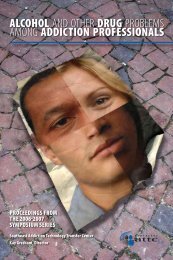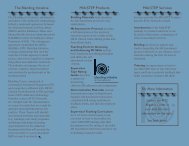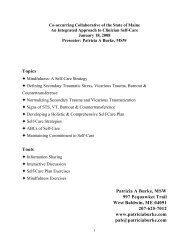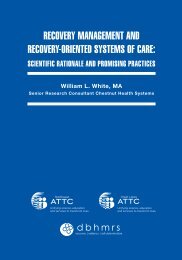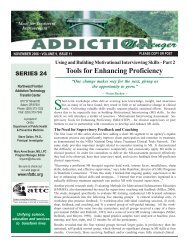Building the Science of Recovery - the ATTC Network
Building the Science of Recovery - the ATTC Network
Building the Science of Recovery - the ATTC Network
Create successful ePaper yourself
Turn your PDF publications into a flip-book with our unique Google optimized e-Paper software.
<strong>Building</strong> <strong>the</strong> <strong>Science</strong> <strong>of</strong> <strong>Recovery</strong><br />
RESEARCH BRIEF • JANUARY 2009<br />
Compiled by: Alexandre Laudet, PhD, National Development and Research Institutes, Inc.<br />
Edited by : Michael T. Flaherty, PhD, Institute for Research, Education and Training in Addictions<br />
and Debra Langer, MSc, MPA, Institute for Research, Education and Training in Addictions<br />
Institute for Research, Education<br />
and Training in Addictions<br />
www.ireta.org<br />
www.neattc.org
© 2009 IRETA<br />
Ne<strong>ATTC</strong>/IRETA<br />
Regional Enterprise Tower<br />
425 Sixth Avenue, Suite 1710<br />
Pittsburgh, PA 15219<br />
(412) 391-4449<br />
www.neattc.org<br />
www.ireta.org<br />
Compiled by Alexandre Laudet, PhD, (<strong>of</strong> National Development and Research Institutes, Inc.) and edited by Michael T. Flaherty, PhD<br />
and Debra Langer MSc, MPA, (both <strong>of</strong> <strong>the</strong> Institute for Research, Education and Training in Addictions) and published by <strong>the</strong> Nor<strong>the</strong>ast<br />
Addiction Technology Transfer Center (Ne<strong>ATTC</strong>), Regional Enterprise Tower, 425 Sixth Avenue, Suite 1710, Pittsburgh, PA 15219.<br />
This publication was prepared by <strong>the</strong> Nor<strong>the</strong>ast Addiction Technology Transfer Center under a cooperative agreement from <strong>the</strong><br />
Substance Abuse and Mental Health Services Administration’s (SAMHSA) Center for Substance Abuse Treatment (CSAT). All material<br />
appearing in this publication except any taken directly from copyrighted sources is in <strong>the</strong> public domain and may be reproduced<br />
or copied without permission from SAMHSA/CSAT or <strong>the</strong> author. Citation <strong>of</strong> <strong>the</strong> source is appreciated. This material should not be<br />
reproduced and distributed for a fee without written authorization from <strong>the</strong> Nor<strong>the</strong>ast <strong>ATTC</strong>. Citation <strong>of</strong> <strong>the</strong> source is appreciated. For<br />
more information on obtaining copies <strong>of</strong> this publication, call (412) 258-8565.<br />
At <strong>the</strong> time <strong>of</strong> publication, Eric Broderick, DDS, MPH served as <strong>the</strong> Acting SAMHSA Administrator. H. Westley Clark, MD, JD, MPH,<br />
CAS, FASAM served as CSAT Director, and Ca<strong>the</strong>rine D. Nugent served as <strong>the</strong> CSAT Project Officer.<br />
The opinions expressed herein are <strong>the</strong> views <strong>of</strong> <strong>the</strong> author and do not reflect <strong>the</strong> <strong>of</strong>ficial position <strong>of</strong> <strong>the</strong> Department <strong>of</strong> Health and<br />
Human Services (DHHS), SAMHSA, or CSAT. No <strong>of</strong>ficial support or endorsement <strong>of</strong> <strong>the</strong> opinions expressed in this document by DHHS,<br />
SAMHSA, or CSAT is intended or should be inferred.<br />
Produced under a grant and contract funded by <strong>the</strong> Center for Substance Abuse<br />
Treatment, Substance Abuse and Mental Health Services Administration, U.S.<br />
Department <strong>of</strong> Health and Human Services; Center for Substance Abuse Treatment,<br />
5600 Fishers Lane Rockwall II, Suite 618, Rockville, Maryland 20857, 301.443.5052. Its<br />
contents are solely <strong>the</strong> responsibility <strong>of</strong> <strong>the</strong> authors and do not necessarily represent <strong>the</strong><br />
<strong>of</strong>ficial views <strong>of</strong> <strong>the</strong>se agencies.<br />
Grant No. 2 UD1 TI013404-06
BUILDING THE SCIENCE OF RECOVERY<br />
Table <strong>of</strong> contents:<br />
PURPOSE, VISION... AND AN INVITATION.................................................................................... 2<br />
BACKGROUND................................................................................................................................. 3<br />
INTRODUCTION............................................................................................................................... 5<br />
WHY DO WE NEED A SCIENCE OF RECOVERY?........................................................................ 5<br />
WHAT DO WE NEED TO KNOW?.................................................................................................... 6<br />
WHAT WILL THE SCIENCE OF RECOVERY TELL US THAT WE DO NOT<br />
ALREADY KNOW?................................................................................................................ 7<br />
CURRENT BARRIERS TO THE SCIENCE OF RECOVERY........................................................... 8<br />
FUTURE DIRECTIONS..................................................................................................................... 9<br />
APPENDIX 1: RECOVERY SYMPOSIUM DAY 2 AGENDA.......................................................... 10<br />
APPENDIX 2: COMPILATION OF RECOVERY-FOCUSED QUESTIONS................................... 12<br />
REFERENCE LIST........................................................................................................................... 17<br />
1
PURPOSE, VISION... AND AN INVITATION<br />
The science <strong>of</strong> addiction has made great strides, largely thanks to <strong>the</strong> generous funding <strong>of</strong> federal agencies such as<br />
<strong>the</strong> NIH and SAMHSA, and <strong>the</strong> vision <strong>of</strong> <strong>the</strong>ir leaders. The empirical knowledge that has resulted from this funding is<br />
invaluable to <strong>the</strong> prevention and treatment <strong>of</strong> addiction and to informing policy and funding decisions that affect not<br />
only <strong>the</strong> lives <strong>of</strong> addiction-affected persons but also that <strong>of</strong> <strong>the</strong>ir families, communities and <strong>of</strong> society at large.<br />
Researchers have made many strides in <strong>the</strong> science <strong>of</strong> addiction, some <strong>of</strong> <strong>the</strong> most significant <strong>of</strong> which have led to consistent<br />
improvement in <strong>the</strong> methods used to investigate its etiology and treatment. Looking to o<strong>the</strong>r biomedical fields to enhance<br />
research and treatment strategies within addictions, we have embraced methodological gold standards such as<br />
large-scale randomized clinical trials as well as effective or promising pharmaco<strong>the</strong>rapies that, as an adjunct to<br />
traditional treatment, have <strong>the</strong> potential to improve <strong>the</strong> lives <strong>of</strong> millions. These include methadone, buprenorphine,<br />
acamprosate, naltrexone, suboxone, and numerous o<strong>the</strong>rs.<br />
In using <strong>the</strong> most sophisticated scientific methods to urgently pursue ‘<strong>the</strong> cure’ to a social ill whose consequences extend<br />
well beyond <strong>the</strong> addicted individual (leading to issues such as HIV/AIDS, Hepatitis C, domestic violence, family disintegration,<br />
social instability, and devastated communities), we must not lose sight <strong>of</strong> <strong>the</strong> phenonemenology <strong>of</strong> addiction and its solution—<br />
‘recovery’ to <strong>the</strong> individual. One <strong>of</strong> <strong>the</strong> most significant ‘discoveries’ within <strong>the</strong> field is identification <strong>of</strong> addiction as a chronic<br />
(some say ‘relapse-prone’) condition. The cardinal trait <strong>of</strong> chronicity is that <strong>the</strong>re is no cure; however, symptoms can be<br />
managed and <strong>the</strong> condition arrested or ‘remitted.’ Unlike o<strong>the</strong>r biomedical fields and illnesses, we currently lack criteria to<br />
recognize or quantify remission from addiction or how that remission is best sustained. This however, is <strong>the</strong> concern<br />
<strong>of</strong> <strong>the</strong> addiction pr<strong>of</strong>essional. Millions <strong>of</strong> formerly addicted individuals worldwide are living pro<strong>of</strong> that remission—‘recovery’—<br />
from addiction is a reality and as many have said to us when preparing this Brief, <strong>the</strong>y do not need a definition or a set <strong>of</strong><br />
criteria. But scientists do, as <strong>the</strong>y must. Therefore, <strong>the</strong> task <strong>of</strong> researchers must be to catch up to this large yet unquantified<br />
and under-investigated group <strong>of</strong> individuals to learn from <strong>the</strong>ir experiences in order to inform services<br />
and policy in an increasingly ‘recovery-oriented’ system <strong>of</strong> care.<br />
As stated later in this Brief, <strong>the</strong> science <strong>of</strong> addiction and <strong>the</strong> science <strong>of</strong> recovery are complementary, not mutually<br />
exclusive. If it is an illness, we must elucidate wellness with <strong>the</strong> same relentless commitment to <strong>the</strong> highest scientific standards<br />
that guide <strong>the</strong> science <strong>of</strong> o<strong>the</strong>r ills. We must also recognize that when seeking to elucidate remission or <strong>the</strong> ‘experience’ <strong>of</strong><br />
recovery from a bio-psycho-social condition that impairs nearly all areas <strong>of</strong> functioning and has for many a spiritual component,<br />
traditional scientific strategies may fail us at times. The questions we ask may differ from those we address when explaining<br />
pathology. The methods we use need to include <strong>the</strong> lived experience <strong>of</strong> our ‘subjects.’ Our ultimate task is to develop<br />
a science that adheres to <strong>the</strong> strictest standards <strong>of</strong> excellence while describing wellness in its many forms to<br />
inform services and ultimately improve lives.<br />
This brief was undertaken as a preliminary roadmap to this scientific destination. It is designed to both highlight what is<br />
currently known about addiction and recovery and to emphasize <strong>the</strong> need for research that focuses on recovery—a very real<br />
yet largely unexamined phenomenon known currently mostly through personal accounts and an emerging science that cannot<br />
progress if held strictly to <strong>the</strong> questions and methods defined in <strong>the</strong> science <strong>of</strong> addiction pathology. This Brief delineates <strong>the</strong><br />
key questions needed to increase our understanding <strong>of</strong> recovery as identified by practitioners, researchers, policymakers and<br />
<strong>the</strong> recovery community.<br />
It is our hope that this work will now serve as an open invitation for all to participate in fur<strong>the</strong>r defining addiction and recovery.<br />
By doing so, we can all contribute to expanding our knowledge base informing <strong>the</strong>se topics as well as defining more clearly<br />
our understanding <strong>of</strong> <strong>the</strong> illness, how it is experienced, and how it can be overcome. The ultimate vision <strong>of</strong> this work is to<br />
provide practitioners with <strong>the</strong> knowledge necessary to <strong>of</strong>fer addiction-affected individuals better opportunities to achieve and<br />
sustain long-term recovery.<br />
2
BACKGROUND<br />
In a seminal report on <strong>the</strong> practice <strong>of</strong> medicine, especially as it relates to <strong>the</strong> management <strong>of</strong> chronic illnesses, <strong>the</strong> Institute<br />
<strong>of</strong> Medicine (IOM; 2001:1) stated that <strong>the</strong> “American health care delivery system is in need <strong>of</strong> fundamental change.” Too<br />
<strong>of</strong>ten, patients do not receive care that “meets <strong>the</strong>ir needs and is based on <strong>the</strong> best scientific knowledge” (IOM, 2001: 145).<br />
Consistent with <strong>the</strong>se statements, in a survey <strong>of</strong> health care systems in five industrialized nations, adults in <strong>the</strong> US were “least<br />
satisfied with <strong>the</strong>ir health care system” (Commonwealth Fund, 2002). The IOM report sparked numerous efforts to examine<br />
<strong>the</strong> healthcare delivery system—both from <strong>the</strong> physical and behavioral health perspectives.<br />
In 2004, seeking to address <strong>the</strong> issues identified by <strong>the</strong> IOM report, <strong>the</strong> Institute for Research, Education and Training in<br />
Addictions (IRETA) convened a group <strong>of</strong> leaders in addictions to study <strong>the</strong> delivery <strong>of</strong> substance abuse treatment services<br />
and to develop a common vision for <strong>the</strong> prevention, intervention, treatment, and recovery from substance use disorders.<br />
The guiding concept <strong>of</strong> this effort was <strong>the</strong> conceptualization <strong>of</strong> addiction, in its most severe form, as a chronic disorder. The<br />
proceedings <strong>of</strong> this multi-year effort and <strong>the</strong> resulting model from <strong>the</strong> collaborative group process, <strong>the</strong> “Resiliency, Wellness,<br />
and <strong>Recovery</strong> Model,” was published in 2006 (Flaherty, 2006). The model emphasized <strong>the</strong> need to adopt a chronic disease<br />
continuity <strong>of</strong> care model to address substance use disorders, and to include early intervention and recovery supports as an<br />
integral part <strong>of</strong> care.<br />
Subsequently, IRETA worked with William White and Dr. Ernest Kurtz, to publish a guide for addiction counselors detailing<br />
a key aspect <strong>of</strong> <strong>the</strong> new model <strong>of</strong> addiction services,—<strong>the</strong> integration <strong>of</strong> recovery support services with treatment (White<br />
& Kurtz, 2006). The guide presented a large body <strong>of</strong> empirical evidence indicating that active linkage and use <strong>of</strong> recovery<br />
support services during and after treatment could significantly enhance treatment and recovery outcomes (Dennis, Scott, &<br />
Funk, 2003; Fiorentine & Hillhouse, 2000; McKay, 2005; Moos & Moos, 2005; Scott, Foss, & Dennis, 2005). The integration <strong>of</strong><br />
recovery support services with treatment as described is just one aspect <strong>of</strong> a larger system designed to focus on and better<br />
support recovery—a recovery-oriented system <strong>of</strong> care (ROSC) (http://www.pfr.samhsa.gov/rosc.html). ROSC is a “network<br />
<strong>of</strong> formal and informal services developed and mobilized to sustain long-term recovery for individuals and families impacted<br />
by severe substance use disorders. The system in ROSC is not a local, state, or federal treatment agency but a macro-level<br />
organization <strong>of</strong> a community, a state, or a nation” (White & Kurtz, 2006: 13). Implementing such a system entails a fundamental<br />
paradigmatic shift from <strong>the</strong> prevalent acute care model where services are delivered in discrete, intense episodes focusing on<br />
symptom elimination for a specific problem and directed by pr<strong>of</strong>essionals, to a continuity <strong>of</strong> care paradigm where wellness is<br />
<strong>the</strong> goal and long-term recovery is viewed as self-sustainable (White & Kurtz, 2006: 9-10).<br />
As empirical evidence continues to build, supporting adoption <strong>of</strong> this new model, it is beginning to be put into practice.<br />
As evidenced by <strong>the</strong>se early implementations and current recovery-related research, <strong>the</strong> model presents many challenges<br />
to service developers, policy makers and researchers, and has generated many questions. These questions need to be<br />
addressed to guide <strong>the</strong> field toward <strong>the</strong> implementation <strong>of</strong> this new addiction service vision and addressing <strong>the</strong>m fully has<br />
required <strong>the</strong> involvement and collaboration <strong>of</strong> all stakeholder groups, including <strong>the</strong> recovery community as well as more<br />
traditional pr<strong>of</strong>essional partners.<br />
IRETA took <strong>the</strong> leadership in moving this agenda forward by coordinating two key initiatives in 2008. The first was to organize<br />
a <strong>Recovery</strong> Symposium, held on May 1-2, 2008, that built upon <strong>the</strong> many national and regional recovery-oriented initiatives<br />
and that brought toge<strong>the</strong>r representatives <strong>of</strong> all key stakeholder groups. The event featured a half-day working meeting in<br />
which a group <strong>of</strong> diverse leaders representing substance use treatment service providers, researchers, recovery, policy, and<br />
funding agency representatives came toge<strong>the</strong>r to learn from each o<strong>the</strong>r’s experiences related to design and implementation<br />
<strong>of</strong> recovery-oriented systems <strong>of</strong> care including exploration <strong>of</strong> barriers and lessons learned. The second day <strong>of</strong> <strong>the</strong> symposium<br />
entailed a full day <strong>of</strong> presentations addressing numerous aspects <strong>of</strong> <strong>the</strong> recovery movement and representing <strong>the</strong> perspective<br />
<strong>of</strong> <strong>the</strong> recovery community, federal, state and city agencies, policy makers, service providers and researcher including Dr. H.<br />
Westley Clark (Substance Abuse and Mental Health Services Administration/ Center for Substance Abuse Treatment), Dr.<br />
George DeLeon (National Development and Research Institutes, Inc.), Karen M. Carpenter-Palumbo (New York State Office<br />
<strong>of</strong> Alcoholism and Substance Abuse Services), and many o<strong>the</strong>rs. (see Appendix 1; Videos <strong>of</strong> <strong>the</strong> Symposium are available<br />
at www.ireta.org). This diversity <strong>of</strong> views is key in creating, funding, delivering and evaluating a recovery oriented service<br />
model that can best address <strong>the</strong> needs <strong>of</strong> individuals and communities affected by substance use disorders. The day-long<br />
symposium included <strong>the</strong> presentation and discussion <strong>of</strong> an agenda for <strong>the</strong> <strong>Science</strong> <strong>of</strong> <strong>Recovery</strong> as detailed below, that was<br />
followed by commentaries from national leaders including, Dr. Robert Forman (Alkermes, Inc.), Dr. Mark Willenbring (National<br />
3
Institute <strong>of</strong> Alcohol Abuse an Alcoholism), Dr. Timothy Condon (National Institute on Drug Abuse), and Drs. A. Thomas<br />
McLellan and Deni Carise (Treatment Research Institute).<br />
IRETA’s second initiative to integrate <strong>the</strong> recovery vision into <strong>the</strong> addiction field entailed partnering with o<strong>the</strong>r organizations<br />
(Great Lakes Addiction Technology Transfer Center and Philadelphia Department <strong>of</strong> Behavioral Health and Mental Retardation<br />
Services) to support <strong>the</strong> preparation <strong>of</strong> a monograph authored by William White laying out <strong>the</strong> empirical support for <strong>the</strong> move<br />
to ROSC (White, 2008; http://www.ireta.org/merchant2/). The monograph was jointly published in June <strong>of</strong> 2008 and is <strong>the</strong><br />
first and most comprehensive systematic review <strong>of</strong> <strong>the</strong> literature to support transition to ROSC and <strong>the</strong> concrete strategies<br />
that will make <strong>the</strong> vision <strong>of</strong> ROSC a reality.<br />
This brief grew out <strong>of</strong> both, planning for <strong>the</strong> recovery symposium and <strong>the</strong> clear need, highlighted in William White’s 2008<br />
monograph, for transformation <strong>of</strong> substance abuse service delivery so that it better promotes long-term recovery. Doing so<br />
will require a robust and thorough empirical basis—<strong>the</strong> science <strong>of</strong> recovery.<br />
4
INTRODUCTION<br />
In preparation for <strong>the</strong> recovery symposium described above, <strong>the</strong> symposium planning group solicited input from various<br />
stakeholder groups about <strong>the</strong> types <strong>of</strong> questions we need to be able to answer to promote long-term recovery, inform<br />
recovery oriented systems <strong>of</strong> care (ROSC) and recovery management (RM) and to minimize current barriers to recoveryoriented<br />
services. We obtained extensive input from <strong>the</strong> recovery community organizations (based on <strong>the</strong> national work <strong>of</strong><br />
Faces and Voices <strong>of</strong> <strong>Recovery</strong> in which <strong>the</strong> organization ga<strong>the</strong>red questions and issues <strong>of</strong> concern to persons in recovery);<br />
surveyed service providers nationwide representing all treatment modalities and <strong>the</strong>rapeutic orientations, funding source<br />
(public and private), agency size, and geography (urban and rural); and obtained input from <strong>the</strong> research community. The<br />
resulting feedback was <strong>the</strong>n organized into broad categories that are presented in this brief (“What do we need to know?”).<br />
A more detailed list <strong>of</strong> topics and questions is presented in Appendix 2. A preliminary summary <strong>of</strong> this brief was presented at<br />
a closed pre-symposium meeting <strong>of</strong> key stakeholders on May 1; audience feedback from this presentation was incorporated<br />
in this final version <strong>of</strong> <strong>the</strong> brief.<br />
This brief summarizes <strong>the</strong> need for and promise <strong>of</strong> <strong>the</strong> <strong>Science</strong> <strong>of</strong> <strong>Recovery</strong>, presents key research questions, and closes with<br />
a summary <strong>of</strong> current obstacles to conducting recovery-oriented research and suggestions for possible future directions.<br />
WHY DO WE NEED A SCIENCE OF RECOVERY?<br />
Decades <strong>of</strong> federally-funded research have resulted in a vast knowledge base about <strong>the</strong> nature (etiology, “causes”),<br />
patterns, consequences and treatment <strong>of</strong> addiction. Information on <strong>the</strong> prevalence <strong>of</strong> alcohol and drug use in <strong>the</strong> past<br />
month/year is easily accessible with a few mouse clicks, analyzable by age, gender, ethnicity, geographic locale, and<br />
employment status. But <strong>the</strong>re is much we do not know—How many people in <strong>the</strong> US are in recovery? How did <strong>the</strong>y<br />
get <strong>the</strong>re?<br />
Treatment can be effective, even though it typically requires multiple episodes <strong>of</strong> care under <strong>the</strong> current service model, but<br />
rates <strong>of</strong> reoccurrence are high even after several years. Less than one-third <strong>of</strong> people with drug or alcohol problems ever seek<br />
treatment. How do we “sell” treatment to those who need it?<br />
Medications that can help achieve (and maintain?) abstinence are currently available or in development and testing phases to<br />
address dependence on a growing number <strong>of</strong> substances. The goal <strong>of</strong> <strong>the</strong>se medications is primary symptom management.<br />
ARE WE CURING ADDICTION?<br />
Addiction is best conceptualized as a chronic brain disorder. As such, it cannot be cured but it can be managed. Comparing<br />
addiction to o<strong>the</strong>r chronic conditions such as diabetes, hypertension or asthma, McLellan (2002) noted <strong>the</strong> many similarities in<br />
<strong>the</strong> etiology, course, treatment and treatment outcomes across chronic conditions. However, more than (or perhaps unlike) any<br />
o<strong>the</strong>r chronic condition, active addiction has deleterious consequences on almost all areas <strong>of</strong> functioning (physical and mental<br />
health, family and social functioning, employment and education, housing, legal status, and overall well-being). Abstinence<br />
from drugs and alcohol is likely a prerequisite to improvement in o<strong>the</strong>r life domains, but it rarely brings instant relief (Vaillant,<br />
1995). Addicted individuals who address abstinence alone are unlikely to maintain that abstinence for a prolonged period.<br />
Individuals need to address “recovery” in <strong>the</strong> multiple life domains affected by active addiction. Note: For many, <strong>the</strong> term<br />
‘recovery’ used to denote regaining something that was lost, is a misnomer as relates to ‘externals’ (materials possessions or<br />
status). Ra<strong>the</strong>r, a recurring <strong>the</strong>me among persons in recovery is that what is regained is an identity (a self) and a potential that<br />
were lost to addiction (Laudet, 2007).<br />
Unlike o<strong>the</strong>r chronic conditions, focusing only on <strong>the</strong> pathology <strong>of</strong> addiction (symptoms) leads to stigma that translates into<br />
discriminatory policies against those who have overcome <strong>the</strong> disease and represents many obstacles to rebuilding lives—<br />
such as in housing, education, labor markets, etc. Many individuals emerge from active addiction with co-occurring mental or<br />
physical health conditions that also carry stigma (most notably mental health issues and HIV/AIDS). Many individuals who have<br />
overcome active addiction experience enduring shame and guilt about <strong>the</strong> impact <strong>the</strong>ir past substance use had on loved ones<br />
and on society. This may result in “spiritual malaise,” depression, and related negative emotions that can hinder recovery. These<br />
secondary symptoms <strong>of</strong> active addiction must be addressed as part <strong>of</strong> <strong>the</strong> recovery process. Would a diabetic experience<br />
relief from his/her condition by undertaking a “searching fearless moral inventory” (4th step)? Would a hypertensive consider<br />
<strong>the</strong> need to make amends (9th step) for actions taken when s/he was symptomatic? Yet, many individuals in recovery from<br />
addiction worldwide do so in <strong>the</strong> context <strong>of</strong> working <strong>the</strong> 12-step recovery program. Thus, while addiction shares many<br />
5
characteristics with o<strong>the</strong>r chronic conditions, it also has a number <strong>of</strong> unique features that require attention when<br />
seeking to elucidate and promote stable remission (recovery).<br />
The World Health Organization defines health as “a resource for everyday life” ra<strong>the</strong>r than as <strong>the</strong> mere “absence <strong>of</strong> symptoms”<br />
(World Health Organization, 1986). In an interview with Bill White, Dr. Clark recently stated that “<strong>Recovery</strong> is more than<br />
abstinence from alcohol and drugs; it is about building a full and productive life in <strong>the</strong> community. Our treatment systems must<br />
reflect and help people achieve this broader understanding <strong>of</strong> recovery” (Clark, 2007). The call is being heard. State by state,<br />
substance use disorder services nationwide are undergoing a historic transformation from <strong>the</strong> prevalent acute care model to<br />
a person-centered, multi-system, continuum <strong>of</strong> WELLNESS-oriented care: recovery-oriented systems <strong>of</strong> care (ROSC).<br />
Though this is beginning to change (e.g., Betty Ford Institute; Betty Ford Institute Consensus Panel, 2007), <strong>the</strong> construct <strong>of</strong><br />
recovery has yet to be adequately defined, deconstructed, and operationalized. Long-term recovery is virtually uncharted<br />
territory. How can we effectively promote something we poorly understand and have not adequately examined?<br />
THUS THE FIRST STEP OF THE ACTION PLAN TO PROMOTE LONG-TERM RECOVERY MUST BE TO DETERMINE WHAT<br />
WE NEED TO KNOW AND TO SEEK ANSWERS.<br />
WHAT DO WE NEED TO KNOW?<br />
What is recovery? Specifically what are <strong>the</strong> required ingredients: abstinence PLUS WHAT? In which domains is<br />
improvement required for <strong>the</strong>re to be “recovery” not only in <strong>the</strong> eyes <strong>of</strong> society but also for <strong>the</strong> individual?<br />
Relatedly, <strong>the</strong>re is preliminary evidence that quality <strong>of</strong> life satisfaction prospectively predicts sustained abstinence<br />
by maintaining motivation (Laudet, Becker, & White, 2008). What constitutes a satisfying quality <strong>of</strong> life in recovery? How<br />
does that change over time?<br />
For individuals to achieve long-term recovery, <strong>the</strong>y need to initiate recovery. Many individuals with severe problems require<br />
multiple attempts before truly initiating <strong>the</strong> recovery process. What needs to “click” in <strong>the</strong> person? What is <strong>the</strong> catalyst? How<br />
can pr<strong>of</strong>essionals (both traditional treatment providers and providers <strong>of</strong> non-traditional support services) shorten <strong>the</strong> typical<br />
addiction career?<br />
For recovery to become long-term, early recovery has to be sustained and solidified. How do we engage <strong>the</strong> community and<br />
o<strong>the</strong>r non-specialty care providers (e.g., primary care physicians) in becoming early interveners to prevent return to active<br />
addiction or o<strong>the</strong>r life loss that may precipitate relapse?<br />
Research shows differences in dependence and cessation trajectories across drug classes (Office <strong>of</strong> Applied Studies,<br />
Substance Abuse and Mental Health Services Administration, 2008); What are <strong>the</strong> implications <strong>of</strong> <strong>the</strong>se findings for recoveryoriented<br />
services, specialty care, recovery outcomes, patterns and determinants?<br />
The risk <strong>of</strong> return to active addiction becomes minimal after 5 or more years <strong>of</strong> abstinence. What else needs to happen<br />
for individuals to achieve and sustain recovery? What is long-term recovery? What degree <strong>of</strong> improvement in which life<br />
domains are required for <strong>the</strong> individual to have something s/he does not want to lose to active substance use?<br />
Multiple paths to recovery—How do people recover? What works? For whom? When? Under which circumstances<br />
(low/high recovery capital, severity, family history, etc.)? Not only to initiate recovery but also to sustain it over five years, ten<br />
years, or for life? Though participation in treatment and 12-step fellowship programs appear effective for some, many do not<br />
participate in ei<strong>the</strong>r and reoccurrence rates are high even among those who do participate. Fur<strong>the</strong>r research is needed on<br />
natural recovery, religious and spiritual recovery, secular recovery with and without <strong>the</strong> assistance <strong>of</strong> mutual aid involvement<br />
and/or pr<strong>of</strong>essional treatment that may include medications, <strong>the</strong> use <strong>of</strong> recovery homes, recovery coaches and o<strong>the</strong>r emerging<br />
forms <strong>of</strong> recovery management. Through <strong>the</strong> multiple pathways available, what are <strong>the</strong> common <strong>the</strong>mes in recovery?<br />
How effective and cost effective are recovery-oriented systems <strong>of</strong> care (ROSC) in terms <strong>of</strong> lives and dollars saved,<br />
communities restored, families reunited, employment rates increased (or absenteeism decreased) and demonstration <strong>of</strong> good<br />
“citizenship”—living up to <strong>the</strong> responsibilities <strong>of</strong> society? This needs to be measured using a longitudinal approach across<br />
isolated episodes <strong>of</strong> specialty care. It is likely that while ROSC represents a greater investment than an individual treatment<br />
episode, <strong>the</strong> approach will save money and lives when evaluated over <strong>the</strong> life <strong>of</strong> an individual’s ‘service career.’<br />
6
What is <strong>the</strong> most effective role <strong>of</strong> peers in recovery services?<br />
How is recovery from addiction similar to and different from recovery from o<strong>the</strong>r chronic conditions? From medical<br />
conditions (e.g., diabetes and arthritis)? From mental health conditions (e.g., depression and PTSD)? From recovery from<br />
o<strong>the</strong>r “addictions” (e.g., internet, gambling, food, sex, and shopping)? What can we learn from o<strong>the</strong>r fields, and, specifically,<br />
for which aspect <strong>of</strong> addiction recovery must we devise specific interventions, paradigms, and/or measures?<br />
There is a high rate <strong>of</strong> co-occurring physical and mental health chronic conditions; to date <strong>the</strong> addictions field has<br />
focused almost exclusively on psychiatric comorbidity and on HIV. How do o<strong>the</strong>r co-morbid chronic conditions affect <strong>the</strong><br />
initiation and maintenance <strong>of</strong> recovery? How do we integrate <strong>the</strong> multiple systems <strong>of</strong> care that are required to support wellness<br />
for persons with multiple conditions?<br />
How do we disseminate <strong>the</strong> message <strong>of</strong> hope and increase <strong>the</strong> attractiveness <strong>of</strong> recovery services?<br />
WHAT WILL THE SCIENCE OF RECOVERY TELL US THAT<br />
WE DO NOT ALREADY KNOW?<br />
Before asking what <strong>the</strong> science <strong>of</strong> recovery will tell us, we must first commit to making <strong>the</strong> science <strong>of</strong> recovery a true<br />
science. The research questions and methods may differ, but <strong>the</strong> same high scientific standards must be upheld so<br />
that <strong>the</strong> science <strong>of</strong> recovery is as good (or better) as <strong>the</strong> science <strong>of</strong> addiction.<br />
The ultimate goal <strong>of</strong> science is to inform clinical practice to improve lives. The science <strong>of</strong> addiction has and will continue to<br />
elucidate “<strong>the</strong> problem” (<strong>the</strong> multiple causes <strong>of</strong> substance use disorders) and to inform strategies to address it. We have a solid<br />
understanding <strong>of</strong> why and how people become substance dependent (e.g., brain studies and biology) that is being translated<br />
into <strong>the</strong>rapies to lead substance dependent persons out <strong>of</strong> addiction. The science <strong>of</strong> recovery will complement <strong>the</strong><br />
science <strong>of</strong> addiction and lead to additional, diverse effective strategies to promote healthy, satisfying, productive<br />
lives among formerly dependent individuals.<br />
The science <strong>of</strong> recovery will inform <strong>the</strong> recovery community as well as service development, policy and funding and make<br />
significant contributions to our nation’s health and its economy. The mere action <strong>of</strong> making wellness a bona fide outcome will<br />
help reinforce <strong>the</strong> fact that recovery from addiction can be and is a reality for many. By extension, this can give hope to <strong>the</strong><br />
many individuals and families affected by substance use disorders and support <strong>the</strong>m in <strong>the</strong>ir search for <strong>the</strong> solution that will<br />
work for <strong>the</strong>m.<br />
Empirically-derived knowledge about recovery as a multi-dimensional, dynamic construct will provide clinicians, <strong>the</strong><br />
recovery community, and o<strong>the</strong>r stakeholders with realistic expectations and goals. It will inform <strong>the</strong> development <strong>of</strong> tools to<br />
measure recovery and identify recovery milestones. This will help track change over time (not only in terms <strong>of</strong> abstinence but<br />
also in terms <strong>of</strong> global functioning), inform changing service/support needs as <strong>the</strong> process unfolds, help payers and prospective<br />
clients to select and evaluate services, and facilitate research to quantify <strong>the</strong> effectiveness and cost-effectiveness <strong>of</strong> recoveryfocused<br />
services. Identifying <strong>the</strong> benefits <strong>of</strong> recovery, not only to society but also to <strong>the</strong> individual, makes recovery-oriented<br />
substance abuse services more attractive than those “selling” abstinence alone. This can contribute to increased help-seeking<br />
among persons with alcohol and o<strong>the</strong>r drug problems, and can ultimately translate into minimizing <strong>the</strong> many costs <strong>of</strong> active<br />
addiction-quantifiable costs such as those for healthcare, crime, infectious diseases and o<strong>the</strong>r medical consequences <strong>of</strong><br />
addiction, loss <strong>of</strong> productivity, and less easily quantifiable costs related to families, children, and communities.<br />
Empirically-derived knowledge about <strong>the</strong> phenomenology <strong>of</strong> long-term recovery (e.g., when is recovery “stable”?<br />
“sustained”?) will contribute to minimizing many <strong>of</strong> <strong>the</strong> current societal barriers to recovery. As mentioned above, <strong>the</strong>se<br />
barriers tend to manifest <strong>the</strong>mselves as discriminating policies and pervasive stigma attached to persons who have a history<br />
<strong>of</strong> addiction related to quality <strong>of</strong> life issues such as employment, housing, and pr<strong>of</strong>essional licensures.<br />
The science <strong>of</strong> recovery will allow us to quantify <strong>the</strong> likelihood <strong>of</strong> recovery from substance use disorders regardless <strong>of</strong> path,<br />
and to identify factors that promote and hinder <strong>the</strong> process. By learning how recovery is attained and sustained, information<br />
will emerge about <strong>the</strong> various “paths” to recovery (pr<strong>of</strong>essional treatment, self help, religious and spiritual recovery, and o<strong>the</strong>rs<br />
perhaps yet unidentified), help determine whe<strong>the</strong>r specific paths are indicated for certain groups <strong>of</strong> individuals and individuals<br />
<strong>the</strong>mselves (depending on severity, substance, gender, comorbidity, recovery or social “capital”). That will provide helping<br />
7
pr<strong>of</strong>essionals and persons experiencing substance use disorders a menu <strong>of</strong> recovery paths from which to choose in <strong>the</strong><br />
same way physicians and <strong>the</strong>ir patients can review and select among strategies to address high cholesterol depending on <strong>the</strong><br />
individuals’ blood levels, medical and family history, and lifestyle.<br />
Identifying <strong>the</strong> critical ingredients <strong>of</strong> recovery at successive stages <strong>of</strong> <strong>the</strong> process will inform recovery oriented systems <strong>of</strong> care,<br />
a service model that is likely to be more cost effective than <strong>the</strong> prevalent acute-care paradigm. Quantifying its effectiveness<br />
and cost effectiveness require “recovery criteria” that do not currently exist.<br />
CURRENT BARRIERS TO THE SCIENCE OF RECOVERY<br />
In structure and focus, addiction research funding thus far has mirrored <strong>the</strong> acute-care model prevalent in clinical practice.<br />
This approach is ill-suited to elucidating recovery from a chronic condition. Fur<strong>the</strong>r, we have looked to o<strong>the</strong>r biomedical<br />
disciplines for scientific standards, at times compromising external validity (“real world relevance”) in <strong>the</strong> process. These<br />
strategies are well-suited to address some questions and have yielded great advances—e.g., treatment effectiveness<br />
studies—but are ill-suited to study recovery.<br />
Key obstacles to conducting (or ra<strong>the</strong>r securing funding for) recovery-oriented research currently include:<br />
n Primary focus on symptoms (substance use) and social (public health and safety) which lead to insufficient attention<br />
on wellness (e.g., quality <strong>of</strong> life and global health)<br />
n<br />
n<br />
n<br />
n<br />
Primary emphasis on <strong>the</strong> biomedical aspects <strong>of</strong> addiction (e.g., brain studies and medication studies) to <strong>the</strong><br />
detriment <strong>of</strong> investigating o<strong>the</strong>r critical determinants <strong>of</strong> remission and recovery (e.g., psychosocial and socio-cultural<br />
environment in addiction and recovery patterns) in an integrated manner.<br />
Emphasis on formal treatment services which lead to insufficient attention on <strong>the</strong> natural history <strong>of</strong> recovery using<br />
various paths; <strong>the</strong> psychosocial environment; social, personal and social ‘capital;’ socio-cultural resources and<br />
obstacles; and family history and community influences on patterns <strong>of</strong> substance use, paths and patterns <strong>of</strong><br />
recovery.<br />
Insufficient long-term studies which lead to emphasis on <strong>the</strong> initiation <strong>of</strong> abstinence ra<strong>the</strong>r than on promotion <strong>of</strong><br />
sustained wellness (i.e., long term recovery).<br />
Most recently: Fiscal austerity favoring shorter studies or large clinical trials <strong>of</strong> <strong>the</strong>rapeutic interventions to <strong>the</strong><br />
detriment <strong>of</strong> long-term observational studies (‘natural history’) that hold great promise to identify paths, patterns and<br />
determinants <strong>of</strong> <strong>the</strong> broader construct <strong>of</strong> recovery.<br />
8
FUTURE DIRECTIONS<br />
Services for people with substance use disorders are gradually becoming more “recovery-oriented” and making two<br />
significant paradigmatic shifts: (1) From <strong>the</strong> acute, intense episode <strong>of</strong> specialty care model to a continuum <strong>of</strong> multisystem<br />
care, and (2) from addressing primary symptoms to promoting global health.<br />
“If addiction is to be studied as a chronic relapsing disease, increased follow-up periods will be necessary to advance our<br />
understanding for achieving and sustaining recovery. Advancing science in this arena will require comprehensive, individually<br />
based, longitudinal data sets” (Hilton, Chandler, & Compton, 2008: 5).<br />
What research funding agencies can do to promote long-term recovery:<br />
n Include recovery as a bona fide topic and major goal area in agencies’ strategic plans—<strong>Recovery</strong> can no longer be<br />
treated as a secondary outcome or as merely abstinence from drugs and alcohol.<br />
n<br />
Earmark research funding (RFA) specifically to elucidate <strong>the</strong> phenomenology (ingredients) <strong>of</strong> recovery and long-term<br />
recovery processes, patterns and <strong>the</strong>ir determinants: Solicit research that:<br />
• Adopts a longitudinal, naturalistic, developmental, “career” perspective (a la Vaillant, Hser, and Moos/Timko).<br />
• Considers <strong>the</strong> multiple paths to recovery-not just treatment.<br />
• Combines quantitative and qualitative methods to gain in-depth knowledge FROM (and about) persons in<br />
recovery.<br />
• Makes wellness (recovery and global functioning), NOT substance use, criminal involvement and employment<br />
only, THE primary outcome.<br />
• Adopt an ecologically valid “person in environment” approach ra<strong>the</strong>r than an individual-level approach only.<br />
• Addresses research questions developed in partnership with service providers (to maximize technology transfer)<br />
and with <strong>the</strong> recovery community (to maximize relevance).<br />
9
APPENDIX 1: RECOVERY SYMPOSIUM DAY 2 AGENDA<br />
Time<br />
Event / Topic / Title and Speakers<br />
7:30 AM - 8:00 AM Registration<br />
8:00 AM - 8:15 AM Welcome<br />
Dr. Michael Flaherty - Executive Director, IRETA and Principle Investigator, Ne<strong>ATTC</strong><br />
Mr. Jim Baker - Chairman, Philadelphia Mayor’s Drug and Alcohol Commission<br />
Mr. Gilbert Gadson - NET Consumer Council<br />
8:15 AM - 9:15 AM Symposium Keynote<br />
Ms. Deb Beck - President/Drug and Alcohol Service Providers Organization <strong>of</strong><br />
Pennsylvania, Member and Policy Co-Chair, State Associations <strong>of</strong> Addiction Services<br />
Consultant<br />
<strong>Recovery</strong>—A Systems Perspective<br />
9:15 AM - 10:45 AM Symposium Panel<br />
10:45 AM - 11:00 AM Break<br />
11:00 AM - 12:00 PM Symposium Panel<br />
Mr. William White - Senior Researcher, Chestnut Health Systems Lighthouse Institute<br />
<strong>Recovery</strong> Oriented Systems <strong>of</strong> Care - Perspectives from Cities and States<br />
Dr. George DeLeon (Moderator) - Director, Center for Therapeutic Community<br />
Research, National Development and Research Institutes, Inc.<br />
Dr. Thomas Kirk - Commissioner, Connecticut Department <strong>of</strong> Mental Health and<br />
Addiction Services<br />
Mr. Phillip Valentine - Executive Director, Connecticut Community for Addiction<br />
<strong>Recovery</strong><br />
Dr. Arthur Evans - Director, Philadelphia Dept. <strong>of</strong> Behavioral Health & Mental<br />
Retardation Services<br />
Ms. Beverly Haberle - Executive Director, Bucks County Council on Alcoholism and<br />
Drug Dependence, Inc.<br />
Ms. Karen Carpenter-Palumbo - Commissioner, NY State Office <strong>of</strong> Alcoholism and<br />
Substance Abuse Services<br />
Ms. Betty Currier - Consultant, Council on Addictions <strong>of</strong> New York State<br />
Aligning Special Population Needs with <strong>Recovery</strong> Oriented Systems <strong>of</strong> Care<br />
Ms. Cheryl Floyd (Moderator) - Executive Director, Pennsylvania <strong>Recovery</strong><br />
Organizations Alliance<br />
Ms. Ting-Fun May Lai - Director, Program Development and Quality Assurance <strong>of</strong><br />
Behavioral Health Services <strong>of</strong> Hamilton Madison House<br />
Mr. Harlan Pruden - Co-Founder and Council Member <strong>of</strong> <strong>the</strong> NorthEast Two-Spirit<br />
Society<br />
Ms. Lisa Mojer-Torres, Esq. - New Jersey Consumer Advocate<br />
Dr. Calvin Trent - Detroit Health Department, Bureau <strong>of</strong> Substance Abuse<br />
10
12:05 PM - 1:20 PM Lunch / Keynote Presentation<br />
1:25 PM - 2:05 PM Respondent Panel<br />
2:05 PM - 2:20 PM Break<br />
A Model for <strong>Recovery</strong> Oriented Systems <strong>of</strong> Care from a National Perspective<br />
Dr. H. Westley Clark - Director, Center for Substance Abuse Treatment, Substance<br />
Abuse and Mental Health Services Administration<br />
Comments on “A Model for <strong>Recovery</strong> Oriented Systems <strong>of</strong> Care from a National<br />
Perspective”<br />
Mr. John J. Coppola (Moderator) - Executive Director, Alcoholism & Substance<br />
Abuse Providers on New York State, Inc., and Representative <strong>of</strong> State Associations <strong>of</strong><br />
Addiction Services<br />
Ms. Melody Heaps - Founder and President, Treatment Alternatives for Safe<br />
Communities<br />
Mr. Mark Parrino - President, American Association for <strong>the</strong> Treatment <strong>of</strong> Opioid<br />
Dependence<br />
Dr. Kenneth Ramsey - President and CEO, Gateway Rehabilitation Center<br />
Ms. Pat Taylor - Executive Director, Faces & Voices <strong>of</strong> <strong>Recovery</strong><br />
2:20 PM - 2:30 PM Introduction for Research Focus<br />
Research and <strong>Recovery</strong><br />
Dr. Robert Forman - Clinical Scientist, Alkermes, Inc.<br />
2:30 PM - 2:55 PM Symposium Presentation<br />
<strong>Building</strong> <strong>the</strong> <strong>Science</strong> <strong>of</strong> <strong>Recovery</strong>: A <strong>Recovery</strong> Research Agenda<br />
Dr. Alexandre Laudet - Director, Center for <strong>the</strong> Study <strong>of</strong> Addictions and <strong>Recovery</strong>,<br />
National Development and Research Institutes, Inc.<br />
3:00 PM - 3:25 PM Symposium Commentary<br />
Comments on a <strong>Recovery</strong> Research Agenda<br />
3:30 PM - 3:55 PM Symposium Commentary<br />
Dr. Tim Condon - Deputy Director, National Institute on Drug Abuse<br />
Comments on a <strong>Recovery</strong> Research Agenda<br />
Dr. Mark Willenbring - Director, Division <strong>of</strong> Treatment and <strong>Recovery</strong> Research, National<br />
Institute on Alcohol Abuse and Alcoholism<br />
4:00 PM - 4:25 PM Symposium Commentary<br />
Comments on a <strong>Recovery</strong> Research Agenda<br />
4:30 PM - 4:50 PM Symposium Summation<br />
Dr. A. Thomas McLellan - CEO, Treatment Research Institute<br />
Where Do We Go From Here?<br />
4:50 PM - 5:00 PM Evaluation and Adjourn<br />
Dr. Michael Flaherty - Executive Director, IRETA and Principle Investigator, Ne<strong>ATTC</strong><br />
Ms. Lonnetta Albright - Director, Great Lakes Addiction Technology Transfer Center<br />
11
APPENDIX 2:<br />
COMPILATION OF RECOVERY-FOCUSED QUESTIONS<br />
ACHIEVING CONSENSUS ON A DEFINITION OF RECOVERY<br />
When “recovery” is “successful” (and that needs to be defined), what actually changes? What is gained (in which life<br />
domains are <strong>the</strong> changes)? Is anything <strong>of</strong> value lost on <strong>the</strong> way to recovery? What are <strong>the</strong> behavioral economics <strong>of</strong> recovery<br />
(gain vs. loss)?<br />
What are <strong>the</strong> critical ingredients/required elements <strong>of</strong> sustained<br />
recovery?<br />
In terms <strong>of</strong> substance use AND global health, i.e., o<strong>the</strong>r key functioning/life areas—mental health; physical health; social/<br />
family; employment/finances; living conditions; access to care; leisure/recreation; spirituality; and what else? This needs to be<br />
examined across subpopulations, primary substances, and by “recovery stages”, among o<strong>the</strong>rs.<br />
DESCRIBING THE RECOVERY PROCESS<br />
n<br />
n<br />
n<br />
n<br />
n<br />
n<br />
What is <strong>the</strong> phenomenology <strong>of</strong> recovery over time—What changes? How does it change?<br />
What is <strong>the</strong> relationship among <strong>the</strong> critical life domains—Are <strong>the</strong>y independent? Are <strong>the</strong>y cumulative? Is abstinence<br />
in addition to a fantastic family life, mediocre health and no job as predictive <strong>of</strong> sustained “recovery” as abstinence<br />
plus a mediocre family life and a mediocre job?<br />
What is <strong>the</strong> absolute and relative importance <strong>of</strong> each <strong>of</strong> <strong>the</strong> life domains/components: To <strong>the</strong> individual (importance<br />
ratings)? To predicting recovery maintenance? e.g., (a) Is abstinence critical to initiate change in <strong>the</strong> o<strong>the</strong>r domains<br />
or vice versa?; (b) is long term abstinence (say 3 years) in <strong>the</strong> absence <strong>of</strong> o<strong>the</strong>r positive changes enough to sustain<br />
recovery or are such persons at increased risks for relapse relative to someone with <strong>the</strong> same abstinence duration<br />
plus positive changes in global functioning? (i.e., is abstinence enough?)<br />
Do <strong>the</strong> relationships and rankings <strong>of</strong> multiple life domains change over time? For example, <strong>the</strong> first few months<br />
one may really enjoy waking up with a clear head or regaining <strong>the</strong> trust <strong>of</strong> family members. Then one wants a job,<br />
social relationships, a larger house, a sense <strong>of</strong> purpose, etc. At that stage, does absence <strong>of</strong> desired/needed change<br />
increase <strong>the</strong> risk <strong>of</strong> return to substance use?<br />
Conversely, what is <strong>the</strong> phenomenology <strong>of</strong> loss/deterioration in <strong>the</strong>se domains? Does deterioration in key life<br />
domains (e.g., mental health or social functioning) lead to loss <strong>of</strong> abstinence or is abstinence lost first? Does that<br />
vary by gender, age, ethnic subgroup, or recovery stage? Could we use this information to develop a more attractive<br />
recovery sales package to various subgroups? How would selling wellness ra<strong>the</strong>r than abstinence influence service<br />
utilization and, ultimately, <strong>the</strong> nation’s health?<br />
Is <strong>the</strong>re a “point <strong>of</strong> no return” to active addiction/dependence—where <strong>the</strong> odds <strong>of</strong> return to active use are essentially<br />
zero—or is it really “once an addict always an addict”? If <strong>the</strong>re is a “point <strong>of</strong> no return”, what is <strong>the</strong> set <strong>of</strong> criteria (e.g.,<br />
a given duration <strong>of</strong> continuous abstinence plus a given “level” <strong>of</strong> functioning in key domains) that allows us to predict<br />
and promote arriving at that point? This speaks to whe<strong>the</strong>r dependence/addiction is a lifelong illness (and restoring<br />
any “rights” or privileges, pr<strong>of</strong>essional or o<strong>the</strong>rwise, to persons with a dependence history).<br />
DESCRIBING THE RECOVERY PROCESS: Chronology<br />
n<br />
n<br />
n<br />
What is “long-term recovery”—specifically how long or does it vary and, if so, according to what?<br />
What are <strong>the</strong> stages <strong>of</strong> recovery? What are <strong>the</strong> important milestones in recovery?<br />
What are typical longitudinal patterns <strong>of</strong> recovery, and what are <strong>the</strong> critical points when people are vulnerable to<br />
relapse—e.g., late-stage relapse-after multiple years <strong>of</strong> abstinence?<br />
12
BENEFITS and ECONOMICS <strong>of</strong> RECOVERY<br />
n<br />
n<br />
n<br />
n<br />
What are <strong>the</strong> psychosocial, medical, and neuro-cognitive changes (improvements) that result from sustained<br />
abstinence?<br />
For <strong>the</strong> community and for society at large, what are <strong>the</strong> “benefits” <strong>of</strong> promoting long-term recovery in terms <strong>of</strong><br />
financial cost savings (specialty care, o<strong>the</strong>r social services, criminal justice system); public health and safety (crime<br />
and infectious disease transmission); productivity/ employment; family/community health; and civic participation?<br />
How do we use this information to “sell” treatment and promote wellness?<br />
How does that compare to <strong>the</strong> current care model?<br />
MEASURING RECOVERY—beyond abstinence<br />
Review existing measures (e.g. Quality <strong>of</strong> Life) and identify or develop a wellness-based comprehensive, multi-dimensional,<br />
psychometrically sound measure <strong>of</strong> recovery that incorporates all relevant life domains, is sensitive to change, and meaningful<br />
to <strong>the</strong> recovery community. For ‘recovery-oriented systems <strong>of</strong> care,’ such a measure is necessary for external accountability<br />
purposes as well as for internal quality assurance and monitoring, and to guide service development and planning.<br />
RECOVERY PATHS<br />
n<br />
n<br />
n<br />
n<br />
n<br />
n<br />
n<br />
n<br />
n<br />
n<br />
n<br />
What are <strong>the</strong> various paths used to initiate and sustain recovery? These may include but are not limited to:<br />
• Natural recovery (no use <strong>of</strong> pr<strong>of</strong>essional services or self-help)<br />
• Different modalities and models <strong>of</strong> pr<strong>of</strong>essional/specialty services (alone or in combination with 12-step or o<strong>the</strong>r<br />
mutual aid). This includes psychosocial and pharmaco<strong>the</strong>rapy.<br />
• 12-step (alone or in combination with specialty care)<br />
• Non 12-step mutual aid/self help (e.g., Secular Organization for Sobriety)<br />
• Culture-specific approaches (e.g., Wellbriety/White Bison)<br />
• Religion and spirituality<br />
• Alternative methods (alone or in combination with any <strong>of</strong> <strong>the</strong> above). This may include acupuncture, hypnosis,<br />
yoga, and meditation.<br />
Are determinants (factors that promote and/or hinder) <strong>of</strong> recovery initiation and maintenance-promoting similar or<br />
different? How can this best be translated into recovery-oriented systems?<br />
If determinants differ by recovery “stage” (milestone), at which point in <strong>the</strong> process do recovery support service<br />
needs change to maximize sustained recovery?<br />
Given <strong>the</strong> desire to quit using, why and how does someone select a given path?<br />
What is <strong>the</strong> prevalence <strong>of</strong> different pathways out <strong>of</strong> addiction?<br />
Which “path” is more effective at engaging someone and achieving early recovery (initiation) given <strong>the</strong> person’s<br />
individual, clinical, or o<strong>the</strong>r characteristics?<br />
Which “path” is more attractive to and effective for going from early to intermediate or sustained recovery?<br />
Assuming each <strong>of</strong> <strong>the</strong> “paths” promotes abstinence, do <strong>the</strong>y “automatically” produce increases in <strong>the</strong> o<strong>the</strong>r<br />
components (global functioning)?<br />
Is abstinence phenomenologically and neuro-cognitively <strong>the</strong> same regardless <strong>of</strong> path—e.g., voluntary, medicationassisted,<br />
and forced abstinence (controlled environment)?<br />
Given an equal duration <strong>of</strong> various “paths”, what is <strong>the</strong> prospective effectiveness <strong>of</strong> each (or combination <strong>the</strong>re<strong>of</strong>) to<br />
lead to sustain continued abstinence and global functioning?<br />
Is <strong>the</strong>re an optimal combination among complementary paths, e.g., pr<strong>of</strong>essional treatment to initiate recovery in<br />
addition to 12-step participation both during treatment and as aftercare?<br />
13
n<br />
n<br />
n<br />
Do specific paths/combinations work best for specific groups <strong>of</strong> individuals (by severity, pre-recovery capital,<br />
gender, etc.)?<br />
Compare/contrast <strong>the</strong> phenomenology and longitudinal patterns <strong>of</strong> recovery across various pathways,. e.g., with<br />
and without active 12-step involvement and/or a spiritual foundation.<br />
Can we identify a typology <strong>of</strong> recovery styles that can guide individual-level recommendations to maximize <strong>the</strong><br />
attractiveness <strong>of</strong> recovery, e.g., not everyone wants to be a 12-stepper. This may be an issue <strong>of</strong> recovery “culture”.<br />
SPECIFIC SERVICES/RECOVERY RESOURCES<br />
PROFESSIONAL TREATMENT/SPECIALTY CARE<br />
n<br />
n<br />
n<br />
12-STEP<br />
n<br />
n<br />
n<br />
n<br />
Is specialty care necessary? For whom? Which level <strong>of</strong> care? Then what?<br />
How can we best identify when/how to move clients from different levels <strong>of</strong> care (residential to IOP, IOP to OP) to<br />
keep people engaged in <strong>the</strong> change process?<br />
Participation in treatment can enhance protective resources (e.g., family support, goal direction, monitoring, friend<br />
and peer norms and models, and rewarding activities) that sustain recovery (Moos & Moos, 2007). How can this be<br />
promoted systematically?<br />
What are <strong>the</strong> critical active ingredients <strong>of</strong> 12-step participation (meeting attendance and involvement such as working<br />
<strong>the</strong> steps or doing service) at successive stages <strong>of</strong> recovery?<br />
Deconstructing <strong>the</strong> 12-steps: What are <strong>the</strong> processes underlying <strong>the</strong> influence <strong>of</strong> each <strong>of</strong> <strong>the</strong>se ingredients on<br />
abstinence (initiation and maintenance) and on global health and functioning?<br />
Is <strong>the</strong>re a 12-stepper pr<strong>of</strong>ile? What are <strong>the</strong> clinical, recovery capital, and demographics <strong>of</strong> persons who benefit from<br />
12-step? (These issues have been investigated most among alcohol-dependent persons. Do findings generalize to<br />
drug-dependent persons as well?)<br />
Unlike pr<strong>of</strong>essional treatment that is <strong>of</strong>ten “evaluated” months after services end (e.g., 6 months post discharge—<br />
outcome data), most studies on 12-step are conducted among individuals who are currently participating<br />
(performance data). What is <strong>the</strong> “effectiveness” <strong>of</strong> 12-step in sustaining abstinence and <strong>the</strong> o<strong>the</strong>r components <strong>of</strong><br />
recovery after someone stops going (outcome)? Does 12-step “stay” with you after you stop going? Specifically<br />
what stays with you? Can we “bottle” this for persons who choose not to go to 12-step?<br />
OTHER SELF-HELP/MUTUAL AID<br />
n<br />
n<br />
n<br />
n<br />
“Inventory” <strong>of</strong> non 12-step addiction recovery support groups<br />
What are <strong>the</strong> reasons for participation in non 12-step groups instead <strong>of</strong> 12-step groups? What are <strong>the</strong> benefits<br />
derived? Are <strong>the</strong>y different than benefits derived from 12-step groups? Is <strong>the</strong>re a certain type <strong>of</strong> individual attracted<br />
to <strong>the</strong>se groups (to inform menu <strong>of</strong> recovery options)?<br />
What is <strong>the</strong> effectiveness <strong>of</strong> o<strong>the</strong>r self-help/mutual aid organizations?<br />
What are <strong>the</strong> underlying mechanisms <strong>of</strong> action for non 12-step groups? Are <strong>the</strong>y different than 12-step groups? (what<br />
are <strong>the</strong> “universals” <strong>of</strong> recovery support groups? What is specific to each? For whom is each best indicated?)<br />
PEER RECOVERY SUPPORT SERVICES (PRSS) AND<br />
RECOVERY SUPPORT SERVICES (RSS)<br />
n<br />
n<br />
n<br />
n<br />
n<br />
What is <strong>the</strong> effectiveness <strong>of</strong> each at promoting entry into treatment (when indicated), abstinence, and global health?<br />
What is <strong>the</strong> effectiveness <strong>of</strong> each in keeping people engaged in <strong>the</strong> change process?<br />
Conduct clinical trials comparing PRSS and RSS vs. standard treatment.<br />
What is <strong>the</strong> cost effectiveness <strong>of</strong> PRSS and RSS compared to standard treatment?<br />
Are PRSS and RSS really different? (does “peerness” matter?)<br />
Are PRSS and RSS more or less effective when <strong>the</strong>y are <strong>of</strong>fered in treatment centers?<br />
14
n<br />
What strategies are most successful in linking individuals leaving treatment (community-based or in jail/prison) to<br />
recovery community resources, including recovery support services?<br />
OTHER<br />
n<br />
n<br />
What is <strong>the</strong> effectiveness and cost effectiveness <strong>of</strong> participation in recovery community institutions (e.g., recovery<br />
homes, recovery schools, recovery industries, recovery support centers, recovery ministries/churches) in enhancing<br />
long-term recovery?<br />
What is <strong>the</strong> potential <strong>of</strong> new technologies to support individual recovery alone or in combination with specialty<br />
care or o<strong>the</strong>r services? For example, telephone or web-based recovery coaches, online support groups, recovery<br />
support text messages. What is feasible? For whom? What is <strong>the</strong> effectiveness and cost-effectiveness <strong>of</strong> <strong>the</strong>se<br />
technologies?<br />
RECOVERY-ORIENTED SYSTEM OF CARE (ROSC):<br />
SERVICE DEVELOPMENT AND FUNDING<br />
n<br />
n<br />
n<br />
n<br />
n<br />
n<br />
n<br />
n<br />
What needs to happen to transition from <strong>the</strong> acute-care model to a recovery-oriented system <strong>of</strong> care (ROSC) at <strong>the</strong><br />
system level (e.g. statewide)? At <strong>the</strong> program level? Within <strong>the</strong> payment system (reimbursement structures)? At <strong>the</strong><br />
clinical level as impacts services from clinicians and o<strong>the</strong>r service providers to individuals?<br />
What do service developers need to know to move a recovery-oriented system <strong>of</strong> care forward?<br />
How do we implement and “sell” a recovery-oriented system <strong>of</strong> care in <strong>the</strong> current beleaguered and deficit-focused<br />
system <strong>of</strong> care?<br />
What can <strong>the</strong> substance use disorder treatment field learn from <strong>the</strong> mental health field and o<strong>the</strong>r fields addressing<br />
chronic conditions about recovery-based care (wellness promotion)?<br />
How does <strong>the</strong> effectiveness and cost-effectiveness <strong>of</strong> ROSC compare to <strong>the</strong> prevalent acute-care model?<br />
Specifically what training do staff (program directors, counselors, o<strong>the</strong>rs) need to transition to a recovery-oriented<br />
continuum <strong>of</strong> care without alienating <strong>the</strong>m by implying that what <strong>the</strong>y have been doing may not be working as well<br />
as we hoped?<br />
Can this training be streamlined (e.g., web-based) for enhanced efficiency?<br />
What is <strong>the</strong> feasibility and effectiveness <strong>of</strong> building performance-contracting into ROSC (assuming we arrive at<br />
recovery measure and criteria)?<br />
MULTISYSTEMS/SERVICE INTEGRATION<br />
n<br />
n<br />
n<br />
n<br />
n<br />
What is <strong>the</strong> best way to coordinate <strong>the</strong> provision <strong>of</strong> a spectrum <strong>of</strong> ancillary services (housing, legal problems, etc.)<br />
with specialty care to provide a truly person-centered system that promotes and sustains long term recovery?<br />
What is <strong>the</strong> best way to integrate pr<strong>of</strong>essional services (specialty care, social services, etc.) with <strong>the</strong> use <strong>of</strong> peers and<br />
volunteers?<br />
How can we foster <strong>the</strong> creation <strong>of</strong> multi-agency, multi-disciplinary service teams?<br />
What are <strong>the</strong> systemic barriers to flexible systems that can accommodate <strong>the</strong> changing needs as recovery<br />
progresses?<br />
Can we learn from o<strong>the</strong>r systems or fields that have identified and successfully effected service integration—e.g.,<br />
mental health, disabilities?<br />
RECOVERY RESOURCES (o<strong>the</strong>r than paths) AND OBSTACLES<br />
n<br />
n<br />
n<br />
Resources and obstacles can be within and/or outside <strong>of</strong> <strong>the</strong> individual<br />
Psychosocial resources are <strong>of</strong>ten investigated but not in an integrated fashion (e.g., cognitions, social environment<br />
and support, spirituality/faith)<br />
Obstacles can include characteristics <strong>of</strong> <strong>the</strong> individual, his or her sociocultural environment, as well as policies<br />
15
Key questions:<br />
n<br />
n<br />
n<br />
n<br />
n<br />
n<br />
n<br />
n<br />
Does <strong>the</strong> individual believe recovery is attainable? Are <strong>the</strong>re successful role models (individuals in recovery or persons<br />
who do not have a substance abuse problem) in <strong>the</strong> immediate environment and in <strong>the</strong> prevalent culture (e.g.,<br />
media)?<br />
What are <strong>the</strong> factors that promote and hinder <strong>the</strong> initiation and maintenance <strong>of</strong> long-term recovery?<br />
How do <strong>the</strong>y interact at various stages and for different populations (e.g., high/low severity, recovery capital etc.)?<br />
At any given recovery “stage” (early, intermediate, or sustained), what is <strong>the</strong> power (explanatory value) <strong>of</strong> each<br />
domain to predict recovery, and how do <strong>the</strong>y interact (is <strong>the</strong>re a cumulative effect?)<br />
Are factors promoting/hindering initiation and maintenance <strong>the</strong> same or different? If different, how do <strong>the</strong>y differ, and<br />
what services and o<strong>the</strong>r support are needed for initiation and maintenance?<br />
What is <strong>the</strong> role <strong>of</strong> family in <strong>the</strong> individual recovery process?<br />
What are <strong>the</strong> stages (and needs) <strong>of</strong> family recovery?<br />
Do stigma and discrimination hinder recovery initiation? <strong>Recovery</strong> maintenance? How so? What policy changes are<br />
needed?<br />
“SPECIAL” POPULATIONS and SOCIOCULTURAL ISSUES<br />
Where feasible, <strong>the</strong> key questions addressed in a comprehensive recovery-focused research agenda must be considered for<br />
large subgroups to determine where differences and similarities lie. This will guide policy and services. Subgroups include but<br />
are not limited to:<br />
n<br />
n<br />
Youth, women, Native Americans, Latinos, dually-diagnosed (co-occurring), people in medically-assisted recovery,<br />
veterans, “older” (over 50!), rural populations, ex-<strong>of</strong>fenders, incarcerated individuals, trauma survivors, persons who are<br />
HIV+ and/or HepC+, persons with multiple dependences or addictions (e.g., substance use and gambling or food).<br />
Identify cross-cultural as well as culture-specific patterns and processes <strong>of</strong> long term remission as a function <strong>of</strong><br />
different socio-political and service delivery contexts. Stated differently: what is <strong>the</strong> role <strong>of</strong> <strong>the</strong> sociopolitical context<br />
in how recovery is conceptualized, sought, attained and experienced?<br />
DISSEMINATING THE MESSAGE OF HOPE/PROMOTING RECOVERY:<br />
HOW DO WE SELL RECOVERY?<br />
n<br />
n<br />
n<br />
n<br />
n<br />
n<br />
How many people in <strong>the</strong> US are in recovery (assuming we have a definition)? How many are in long-term recovery?<br />
(this would give <strong>the</strong> recovery movement a ‘’constituency” to advocate for services, funding and policy change.)<br />
How do we disseminate <strong>the</strong> message that long-term recovery is attainable and <strong>the</strong>re are multiple paths to achieve it?<br />
Are <strong>the</strong>re ways to think about <strong>the</strong> styles <strong>of</strong> recovery (identity and relational patterns) that will encourage more<br />
individuals to seek and sustain <strong>the</strong>ir recovery given that current treatment is not attractive to many who need it?<br />
What are effective ways/venues to communicate with people needing/seeking recovery, to engage and sustain <strong>the</strong>m<br />
in that pursuit? What “sells” recovery? What sells treatment? Clearly <strong>the</strong> promise <strong>of</strong> abstinence is not enough.<br />
What are effective ways to communicate with people about how to evaluate and use information about pathways to<br />
recovery to make informed choices?<br />
What role does <strong>the</strong> media portrayal <strong>of</strong> people with addiction problems and <strong>the</strong> coverage <strong>of</strong> addiction issues have in<br />
encouraging (or not) people to seek and sustain <strong>the</strong>ir recovery?<br />
16
Reference List<br />
Betty Ford Institute Consensus Panel. (2007). What is recovery? A working definition from <strong>the</strong> Betty Ford Institute. Journal <strong>of</strong><br />
Substance Abuse Treatment, 33(3), 221-228.<br />
Clark, W. (2007). <strong>Recovery</strong> as an organizing concept. Retrieved February 7, 2008 from http://www.glattc.org/Interview%20<br />
With%20H.%20Westley%20Clark,%20MD,%20JD,%20MPH,%20CAS,%20FASAM.pdf<br />
Commonwealth Fund, The. (2002). Five-nation survey: US adults least satisfied with health system. The Commonwealth Fund<br />
Quarterly, 8(1), 1-11.<br />
Dennis, M.L., Scott, C.K., & Funk, R. (2003). An experimental evaluation <strong>of</strong> recovery management checkups (RMC) for people<br />
with chronic substance use disorders. Evaluation and Program Planning, 26(3), 339-352.<br />
Fiorentine, R. & Hillhouse, M. (2000). Drug treatment and 12-step program participation: The additive effects <strong>of</strong> integrated<br />
recovery activities. Journal <strong>of</strong> Substance Abuse Treatment, 18(1), 65-74.<br />
Flaherty, M.T. (2006). A unified vision for <strong>the</strong> prevention and management <strong>of</strong> substance use disorders: <strong>Building</strong> resiliency,<br />
wellness and recovery—a sift from an acute care to a sustained care recovery management model. Pittsburgh, PA: Institute<br />
for Research, Education and training in Addictions.<br />
Hilton, T.F., Chandler, R.K., & Compton, W.M. (2008). Needed: longitudinal research that can inform dynamic models for <strong>the</strong><br />
treatment <strong>of</strong> addiction as a disease. Evaluation Review, 32, 3-6.<br />
Institute <strong>of</strong> Medicine. (2001). Crossing <strong>the</strong> quality chasm: A new health system for <strong>the</strong> 21st century. Washington, DC: National<br />
Academy Press.<br />
Laudet, A.B. (2007). What does recovery mean to you? Lessons from <strong>the</strong> recovery experience for research and practice.<br />
Journal <strong>of</strong> Substance Abuse Treatment, 33, 243-256.<br />
Laudet, A., Becker, J., & White, W. (2008). Don’t wanna go through that madness no more: Quality <strong>of</strong> life satisfaction as<br />
predictor <strong>of</strong> sustained substance use remission. Substance Use and Misuse (in Press).<br />
McKay, J.R. (2005). Is <strong>the</strong>re a case for extended interventions for alcohol and drug use disorders? Addiction, 100(11), 1594-<br />
1610.<br />
McLellan, A.T. (2002). Is addiction an illness? Can it be treated? In Haack, M.E.R. & Adger, Jr., H. (Eds.), Strategic Plan for<br />
Interdisciplinary Faculty Development: Arming <strong>the</strong> Nation’s Health Pr<strong>of</strong>essional Workforce for a New Approach to Substance<br />
Use Disorders. Providence, RI: Association for Medical Education and Research in Substance Abuse, pp. 67-94.<br />
Moos, R. & Moos, B. (2005). Paths <strong>of</strong> entry into alcoholics anonymous: Consequences for participation and remission.<br />
Alcoholism: Clinical & Experimental Research, 29(10), 1858-1868.<br />
Moos, R.H. & Moos, B.S. (2007). Protective resources and long-term recovery from alcohol use disorders. Drug and Alcohol<br />
Dependence, 86, 46-54.<br />
Office <strong>of</strong> Applied Studies, Substance Abuse and Mental Health Services Administration. (2008). The NSDUH Report: Substance<br />
Use and Dependence Following Initiation <strong>of</strong> Alcohol or Illicit Drug Use. Rockville, MD: SAMHSA. Retrieved on November 18,<br />
2008 from http://www.oas.samhsa.gov/2k8/newUseDepend/newUseDepend.htm<br />
Scott, C.K., Foss, M.A., & Dennis, M.L. (2005). Pathways in <strong>the</strong> relapse-treatment-recovery cycle over 3 years. Journal <strong>of</strong><br />
Substance Abuse Treatment, 28(Supplement1), S63-S72.<br />
Vaillant, G.E. (1995). The Natural History <strong>of</strong> Alcoholism Revisited. Cambridge, MA: Harvard University Press.<br />
White, W. (2008). <strong>Recovery</strong> Management and <strong>Recovery</strong>-Oriented Systems <strong>of</strong> Care: Scientific Rationale and Promising<br />
Practices. Pittsburgh, PA: Nor<strong>the</strong>ast Addiction Technology Transfer Center.<br />
White, W. & Kurtz, E. (2006). Linking addiction treatment and communities <strong>of</strong> recovery: A primer for addiction counselors and<br />
recovery coaches. Pittsburgh, PA: Nor<strong>the</strong>ast Addiction Technology Transfer Center.<br />
World Health Organization—European Regional Office. (1986). Copenhagen, Denmark: WHO.<br />
17
HMark 6.5x9 BW Highmark:Layout 1 8/28/08 3:34 PM Page 1<br />
COMMUNITY IS SOMETHING WE ALL CELEBRATE.<br />
A healthy community supports families and individuals in making <strong>the</strong> most <strong>of</strong> <strong>the</strong>ir lives. At Highmark,<br />
we believe in streng<strong>the</strong>ning communities through programs and services that help people live longer,<br />
healthier lives. Programs promoting health and wellness, injury and disease prevention, and even<br />
economic and community development. And by encouraging our many generous employees who<br />
devote countless hours to community service. Because when people choose to invest in <strong>the</strong>ir<br />
community, that’s cause for celebration.<br />
An Independent Licensee <strong>of</strong> <strong>the</strong><br />
Blue Cross and Blue Shield Association<br />
18
We are pleased to support your efforts to improve our community’s health.<br />
650 Smithfield Street, Center City Tower, suite 2400<br />
Pittsburgh, PA 15222 • 412.594.2550<br />
www.jhf.org • www.prhi.org<br />
<strong>Recovery</strong> Management and<br />
<strong>Recovery</strong>-oriented Systems <strong>of</strong> Care:<br />
Scientific Rationale and Promising Practices<br />
William L. White, MA<br />
Senior Research Consultant Chestnut Health Systems<br />
NEW<br />
Institute for Research, Education and Training in Addictions<br />
IRETA • 425 Sixth Avenue, Suite 1710 Pittsburgh, PA •<br />
www.ireta.org 412-258-8565<br />
Pioneering new Monographs available for<br />
down-load or in print. Visit www.ireta.<br />
org and www.glattc.org. Add <strong>the</strong>se vital<br />
publications to your library.<br />
19
They’re still <strong>the</strong>re. The man you once<br />
were. The daughter you once knew. The<br />
employee you once hired. At Gateway,<br />
we help rediscover <strong>the</strong> lives lost to<br />
addiction. We’ve been providing hope<br />
for those suffering from alcohol and<br />
drug dependency since 1972. So if you,<br />
a member <strong>of</strong> your family, or someone in<br />
your business has a problem with alcohol<br />
or drugs, call Gateway Rehabilitation<br />
Center today at 800-472-1177 or visit our<br />
website at gatewayrehab.org.<br />
Proud to Support <strong>the</strong> <strong>Recovery</strong> Symposium<br />
20
Institute for Research, Education<br />
and Training in Addictions<br />
www.ireta.org<br />
www.neattc.org<br />
425 Sixth Avenue Suite 1710, Pittsburgh, PA 15219 • Phone: 412-258-8565 • Fax: 412-391-2528


